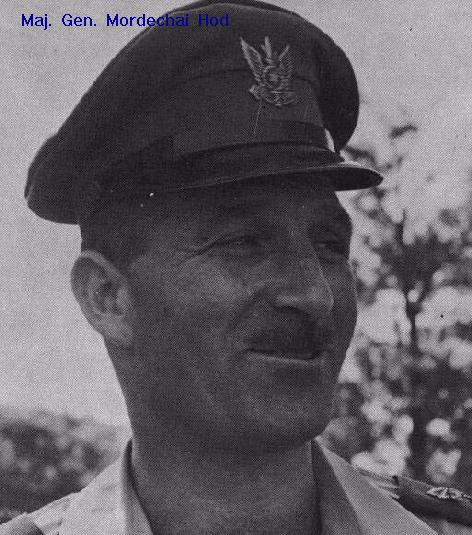2. Some early variations of "Moked" were planned, but not carried out, during the years of escalating tension with the Syrians.
3. The "Moked" full scheme was planned in 1965.
The draft program was built by the operations branch ("Air/1") in the IAF-H.Q. The credits for the "Moked" detailed design go mostly to Lt. Col. Yaakov Nevo, head of Operations ("Air/1") section. of the IAF HQ. and to his assistant, major Rafi Sivron.
4. "Moked", as a final plan for the first strike on Egyptian, Syrian and Jordanian air bases, was published towards the end of 1965, based on the whole array of serviceable fighters (Ouragans to Mirages) in invenrory.
5. When published, the IAF practiced and rehearsed this order for years, by generations of crewmen, in active and in reserve service.

Maj. Gen. Mordechai Hod, IAF Commander in the Six Days War.
7. The concept of attacking some 20 airfields was built around four "Range Circles", the first included the nearest bases in Sinai, the second - Canal Suez zone, the third - the Nile Delta and the fourth, the furthest, Upper (Southern) Egypt. The Vautours were assigned to the 4th circle, its distance no other type could reach.
8. The targets were often photoed, by the 3 Vautours BR (only two survived at the end of 1964) and by few Mirages adapted for photo- recce. Undoubtedly the intelligence gathered by those sorties was one of the main factors for the surprise and the success of the first strike.
9. The principles of "Moked" were, in short:
And see:
[ THE MIDDLE EAST MAP and TABLE OF DISTANCES ]
"THE KNIGHTS OF THE NORTH"
- 18 Vautours were combat-ready on the morning of June 5th.
- A: 03, 05, 07, 08, 09, 12, 14, 17, 18, 21, 26
- N: 62, 65, 66 (also for PR and EW), 67, 70 (EW)
- BR: 31, 33
- |----------------------------------------------------------|
- TOTAL [ A-11, N-5, BR-2 ] = 18
- N: 62, 65, 66 (also for PR and EW), 67, 70 (EW)
A formation of four Vautours was secretely transferred from Ramat David to Tel-Noff AFB, the night of June 4 - june 5, planned to attack first the distant Bani-Suef AFB.
AIRCREW
The squadron's aircrews strength was 32 in total: 25 pilots and 7 navigators. The aircrew were a mixture of regulars with reinforcement of reservists and E.Ps. ( Ramat David Wing Commander, Y. Somech, also participated in one operational sortie ). While the quantity of pilots was quite enough, there was during all the war a shortage of IIN navigators, in some sorties the pilots flew "solo".- Pilots:
- Zur Levi - Major, Sqn. Commander.
- Bodinger Hertzle , Lt. (E.P. Instructor)
- Dvir Michael , Lt.
- Fridman-Rom Avshalom
- Gal Yaakov
- Gil Micha
- Golan-Glantz Itschak, Captain. Vice-commander "B". (Promoted to Major after return from captivity).
- Goren Giora , Lt.
- Goren Ran (res.), Lt.
- Ilan Daniel
- Keren Shlomo, Captain. Vice-commander "A". (Promoted to Major after death).
- Magen Gideon (res.), Captain.
- Margalit Uri
- Nachman Ovadia (E.P.), Major.
- Nir Itschak, Lt. Operations Officer.
- Rafaeli Yaakov ("Kuf-Kaf")
- Saar Moshe ("Simi"), (E.P.), Major.
- Tal Yaakov, Lt.
- Tavor Zeev (res. test pilot, IAI), Captain.
- Tsiddon-Chatto Yoash (res.), Lt. Col.
- Tzivoni Adam (E.P. IAF HQ / "Air-3" section), Lt. Col.
- Tzur Ran ("Tzoran"), Lt.
- Vilan-Weiland Avraham (E.P.), Lt. (promoted to Captain after return from captivity.)
- Zimon Shimon
- Zohar (Simkin) Ben-Tzion (res.), Captain.
- Navigators:
- Ben-Shua Shabtai , Sec. Lt.
- Inbar-Meltzer Alexander, (E.P), Captain.
- Eini Menachem , captain.
- Erez Oded (E.P.), Major. [Posted in Paris, joined 7/6 ].
- Eyal-Los Achikar (E.P. IAF HQ), Major.
- Raz Elchanan , Lt.
- Talmor Uri (E.P IAF HQ), Major.
- ------
- @) Natan Segal, Lt. - Technical Officer
- @) Yosef Levin ( NCO, Res.) - senior technician
- ------


